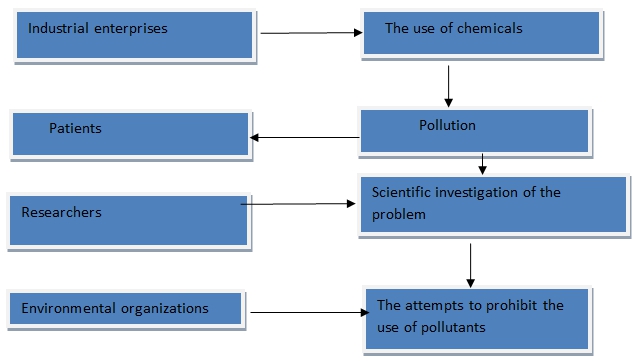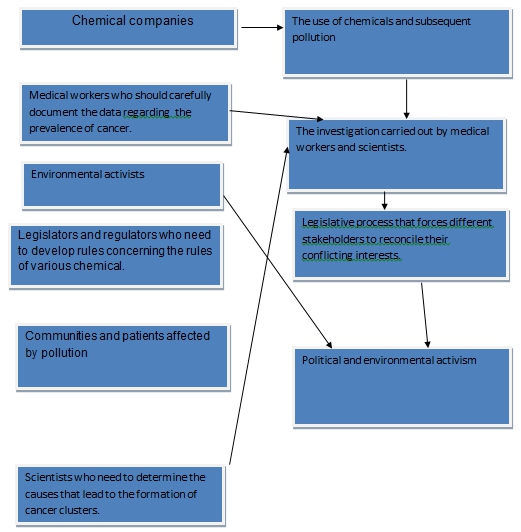Introduction
This paper is aimed at discussing the book Tom’s River by Dan Fagin and the movie Living Downstream which is based on Sandra Steingraber’s book. Overall, these works throw light on the way in which the experiences of separate individuals are affected by the existent environmental practices. The authors try to raise people’s awareness about the danger of environmental pollution. Moreover, they evoke sympathy for people who can be affected by these problems. Nevertheless, Sandra Steingraber and Dan Fagin construct different narratives which can tell how people’s attitudes towards this issue have evolved. Overall, the discussion of these questions can be important for understanding the factors leading to changes in environmental law.
Diagrams
It is possible to construct several diagrams that can identify the main processes and actors discussed by the authors. Moreover, these charts will illustrate the connections between processes and stakeholders.


Comparison of the film and the book
Overall, in both cases, the authors explore the health problems and their environmental origins. For instance, the film Living Downstream explores the use of carcinogens and their impact on human health ((Shields, 2010)). In turn, Dan Fagin (2013) examines the practices of chemical companies and the way in which they contributed to the formation of cancer clusters in different regions. Nevertheless, the authors adopt different strategies in order to attract the readers’ attention to the problem.
In particular, the film Living Downstream links the problem of environmental pollution to the experiences of people who have been diagnosed with cancer. Moreover, this movie highlights the difficulties of researchers who try to find the connections between the use of chemical pollutants and the risk of cancer. In turn, Dan Fagin attempts to construct a scientific narrative that can engage the readers. In both case, the authors rely on the opinions of scientists and medical workers who explain how environmental pollution can lead to cancer.
This strategy is important for helping the audience understand the topic. In turn, the film Living Downstream incorporates a strong appeal to action. In particular, the movie shows how dangerous it is to remain indifferent of pollution and its aftereffects. This book is written from the perspective of a person who is personally affected by environmental pollution. In turn, Dan Fagin is also willing to prompt people to take a more active part in the life of the country, especially the development of environmental laws.
This is why he focuses on the campaigns launched by Greenpeace activists who brought significant changes into the work of environmental agencies (Fagin, 2013, p. 194). Thus, his book also demonstrates that the work of such organizations should be supported. These are some of the points that should be considered since they are important for understanding the arguments of both authors.
Overall, the movie and the book identify similar underlying causes of the problems. In particular, one should speak about the need to achieve economic growth almost at any cost. Additionally, the authors focus on the lack of awareness about the dangerous effects of different toxins.
This argument is supported by other scholars who focus on the need to increase the environmental consciousness of people who should understand how their activities can affect nature (Uhl, 2013). Moreover, they should keep that the preservation of the environment is critical for the welfare of the community (Uhl, 2013). Furthermore, Dan Fagin urges the readers not to overlook the neglect of policy-makers who may turn a blind eye to the problem of pollution.
In contrast, the solutions to this issue are very diverse. This is why he emphasizes the work of local as well as state agencies that should monitor the activities of industrial enterprises (Fagin, 2013, p. 268). The movie Living Downstream lays stress on the efforts of separate individuals who are willing to take actions again irresponsible actions of different stakeholders (Shields, 2010). In many cases, their activities lead to changes in the work of legislators.
These are some of the points that should be considered. In my opinion, it is possible to accept the arguments put forward by the authors because they accurately describe the dangers of environmental pollution. Moreover, they provide compelling evidence showing how difficult it is to change environmental legislation. This is one of the aspects that should be taken into account.
It is important to mention that Sandra Steingraber and Dan Fagin discuss the problem from slightly different positions. In particular, Sandra Steingraber examines the topic from the position of a cancer survivor. She is an individual who is directly affected this dangerous disease (Steingraber, 2010).
Therefore, this author can be strongly interested changing the activities of businesses and legislators. Moreover, she is willing to make sure that other people do not have to pass through the same suffering. In turn, Dan Fagin discusses this topic from the position of a scientist who wants to show the connections between industrial practices and people’s health. The author examines such a phenomenon as cancer clusters and their underlying causes (Fagin, 2013).
Nevertheless, Dan Fagin also supports people who struggle to bring changes into environmental practices. Thus, despite some differences in the tone of the narrative, one can say that Dan Fagin and Sandra Steingraber are deeply concerned about the question that they discuss. This is one of the reasons why their arguments seem more convincing.
Furthermore, one should pay close to the actors that are identified by Sandra Steingraber and Dan Fagin. In particular, Dan Fagin identifies various stakeholders such as community members that are at a greater risk of developing various forms of cancer. Additionally, the author examines the role played by industrial enterprises that are interested in the use of chemicals.
Moreover, the scholar focuses on the activities of governmental officials who often have to resolve conflicting interests of various social groups while making judgments about the legal status of different chemicals. The duty of these professionals is to maximize the welfare of the community. Unfortunately, in many cases, these people do not have sufficient information for making decisions. Finally, Dan Fagin discusses the work of medical professionals who should be able to identify dangerous trends as early as possible.
For instance, they can help scientists discover the existence of cancer clusters. Sandra Steingraber also pays attention to the role played by these stakeholders. Nevertheless, this scholar also focuses on the activities of researchers who try to establish the link between environmental causes and the risk of cancer. The movie shows that the work of these people is often underestimated and underfunded (Shields, 2010). However, they can profoundly influence the decision of public officials.
Apart from that, the analysis of these sources throws light on the advantages and disadvantages of different media. For instance, the textual format enables Dan Fagin to present various factual data cannot be easily discussed within several hours. However, a person has to spend much more time in order to get the gist of the key ideas discussed by the author. In contrast, the video format helps the authors to use convincing images that can illustrate the dangers of industrial pollution.
Moreover, this approach is more important for portraying the emotions of people who can be affected by the problem of environmental pollution. Nevertheless, video format is not sufficient for explaining technical details. For instance, Dan Fagin is able to illustrate the process through which scientists discovered the detrimental effects of various pollutants. Moreover, this author is able to examine the conflicting priorities of different stakeholders, especially policy-makers.
This question cannot be fully discussed within a film. Nevertheless, in both cases, the messages conveyed by the authors are quite convincing because they eloquently highlight the need for improved environmental protection. In both cases, this goal is attained by examining the experiences of people who can be directly or indirectly influenced by environmental threats. These are the main details that should be singled out.
While comparing the book and the movie, one should also mention that Dan Fagin and Sandra Steingraber examine the problem from the political perspective. They pay attention to the attitudes of public officials who need to reconcile the interests of different groups such as businesses and community residents.
Yet, Dan Fagin also focuses on the ethical responsibilities of scientists who should provide unbiased evaluation of different environmental issues that may influence people’s health. Furthermore, this author lays stress on the ethical duties of governmental officials. In turn, Sandra Steingraber speaks about the importance of environmental consciousness which can be critical for the transformation of public policies. This is one of the differences that should not be overlooked.
Conclusion
On the whole, this comparison indicates that Dan Fagin and Sandra Steingraber attach much importance to the efforts of environmental activists who attempt to raise people’s awareness about the dangers of pollution. Their perspective differs slightly since Dan Fagin examines this problem as a researcher and investigator.
In contrast, Sandra Steingraber seems to be much more engaged in this issue since she is a person who struggled with severe health problems that could have been caused by environmental pollution. However, both authors convey a powerful message to the audience. In particular, the readers and viewers should see how their lives can be influenced by current environmental practices. Finally, the book can show how the changes in environmental law can be introduced. These are the main arguments that can be advanced.
Reference List
Fagin, D. (2013). Toms River: A Story of Science and Salvation. New York, NY: Random House Publishing Group.
Shields, N. (Executive Producer). (2010). Living Downstream [DVD]. New York, NY: The People’s Picture Company.
Steingraber, S. (2010). Living Downstream: An Ecologist’s Personal Investigation of Cancer and the Environment. New York, NY: Da Capo Press.
Uhl, C. (2013). Developing Ecological Consciousness: The End of Separation. New York, NY: Rowman & Littlefield.